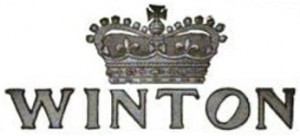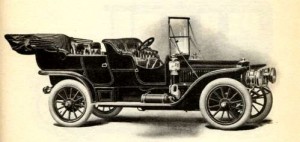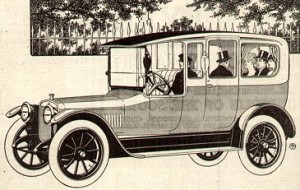The Winton Motor Carriage Company – Scottish immigrant Alexander Winton (1860-1932), owner of the Winton Bicycle Company, 1892-1897, turned from bicycle production to an experimental single-cylinder automobile dos-a-dos model . B.F. Goodrich made the tires for this experimental Winton in 1896 which was the first use of pneumatic tires made for an automobile. Alexander Winton paid $400.00 for the molds. The Winton Motor Carriage Company was incorporated on March 15, 1897.
– Scottish immigrant Alexander Winton (1860-1932), owner of the Winton Bicycle Company, 1892-1897, turned from bicycle production to an experimental single-cylinder automobile dos-a-dos model . B.F. Goodrich made the tires for this experimental Winton in 1896 which was the first use of pneumatic tires made for an automobile. Alexander Winton paid $400.00 for the molds. The Winton Motor Carriage Company was incorporated on March 15, 1897.
By May of 1897, Winton had produced two fully operational prototype automobiles. The second of which was driven from Cleveland to Elyria some 60 miles to prove its durability. However, the new invention was still subject to much skepticism. To prove his automobile’s durability and usefulness, Alexander Winton had his car undergo an 800-mile endurance run from Cleveland to New York City. Starting on July 28, 1897 and finishing in New York on August 7. Winton completed the drive in 78 hours and 43 minute of running time.
On March 24, 1898 Robert Allison of Port Carbon, Pennsylvania became the first person to buy a Winton automobile. The selling price was $1000.00. The Winton Motor Carriage Company sold twenty-one vehicles that year, including one to James Ward Packard, who later founded the Ohio Automobile Company in September of 1900 after Winton challenged a very dissatisfied Packard to do better. The Ohio Automobile Company later became known as the Packard Automobile Company after moving to Detroit in 1903.
In 1899, more than two-hundred Winton vehicles were sold, making the company the largest vertically integrated manufacturer of gas-powered automobiles in the United States. This success led to the opening of the first automobile dealership by Mr. H.W. Koler in Reading, Pennsylvania. To deliver the vehicles, in 1899, Winton built the first auto hauler in America and also sold the first mail delivery vehicle to the US Post Office. Winton drove from Cleveland to New York a second time leaving on May 22 and arriving in New York five days later. This time he had promoted the drive to over 30 newspapers all across the country and used the word “automobile” (a French term) thus helping turn it into a vogue word describing the vehicle. He also cut his time down to 47 hours and 34 minutes of running time for the trip.
 Publicity generated sales and in 1901 the news that both Reginald Vanderbilt and Alfred Vanderbilt had purchased Winton automobiles boosted the company’s image substantially. That same year on October 10, Winton lost a race at Grosse Pointe, Michigan to Henry Ford. Ford won the grand prize of $1000 and a glass cut punch bowl. Ford used the $1000.00 to start his second company The Henry Ford Company which later became Cadillac.
Publicity generated sales and in 1901 the news that both Reginald Vanderbilt and Alfred Vanderbilt had purchased Winton automobiles boosted the company’s image substantially. That same year on October 10, Winton lost a race at Grosse Pointe, Michigan to Henry Ford. Ford won the grand prize of $1000 and a glass cut punch bowl. Ford used the $1000.00 to start his second company The Henry Ford Company which later became Cadillac.
In late1902 Winton produced the first series of the Bullet racers. Bullet number one raced Ransom Olds promoting the Ormond Hotel in Florida. Those Ormond Beach races became popular and later became known as the Daytona 500. The next two Winton Bullets two and three were raced in Ireland at the fourth Gordon Bennett cup race. Both race cars came in eighth place. Bullet number three crashed in 1905 with Earl Kiser at the wheel at the Glenville track in Cleveland, Ohio.
The racer was supposedly scrapped and Winton vowed never to enter his company into race again. However, Barney Oldfield and others did some barnstorming with Wintons a few years thereafter.
In 1903, Dr. Horatio Nelson Jackson made the first successful automobile drive across the United States. He purchased a slightly used Winton touring car from the Wells Fargo Company paying $3000 for it and hired a mechanic by the name of Sewall Crocker to accompany him.
The trip took 64 days, including breakdowns, delays while waiting for parts to arrive especially in Cleveland and $8000.00 of his own money. Jackson’s Winton is now part of the collections at the National Museum of American History in Washington D.C.
Winton continued to successfully market automobiles to upscale consumers through the  1910s, but sales began to fall in the early 1920s. This was due to the very conservative nature of the company, both in terms of technical development and styling. Only one sporting model was offered – the Sport Touring, with the majority of Wintons featuring tourer, sedan, limousine and town car styling.
1910s, but sales began to fall in the early 1920s. This was due to the very conservative nature of the company, both in terms of technical development and styling. Only one sporting model was offered – the Sport Touring, with the majority of Wintons featuring tourer, sedan, limousine and town car styling.
The Winton Motor Carriage Company ceased automobile production on February 11, 1924.Selling its parts tooling and dies to the General Parts Company of Flint, MI which serviced Winton automobiles up to 1927. However, Winton continued in the marine and stationary gasoline and diesel engine business, an industry he entered in 1912 with the Winton Engine Company. Winton developed the first all American diesel engine in 1913.
Winton Engine Company was purchased by General Motors, on June 20, 1930. It produced the first practical two-stroke diesel engines in the 400 to 1,200 HP range, which powered early Electro-Motive Corporation (another GM subsidiary) diesel locomotives and U.S. Navy submarines. A Winton 8-cylinder, 600-horsepower 8-201-A diesel engine was the motive power of the revolutionary Burlington Zephyr streamliner passenger train, in 1934 the first American diesel-powered train, which set a record from Chicago to Denver at a speed of 110 miles an hour. That part of Winton devoted to the manufacturing of diesel locomotives in 1935 became part of the Electro-Motive Corporation (later the Electro-Motive Division of General Motors), and provided 201 series engines for rail use until late 1938, when the EMC designed 567 series engines were introduced. Successor EMD is still in business today.
By 1936 Winton was producing engines only for marine, U.S. Navy, and stationary applications. GM reorganized the company in 1937 as the Cleveland Diesel Engine Division of General Motors. Cleveland engines were used widely by the U.S. Navy in the Second World War, powering submarines, destroyer escorts, and numerous auxiliaries. After the war the Winton designed engines were gradually replaced with similar sized EMDs. The Cleveland Diesel Engine Division closed in 1962.
Additional information www.wintonhistory.com
Also check out Winton World Wide: http://wintonworldwide.com/
View Winton thumbnail photos list thanks to Concept Carz: http://www.conceptcarz.com/view/model/659/Winton.aspx




